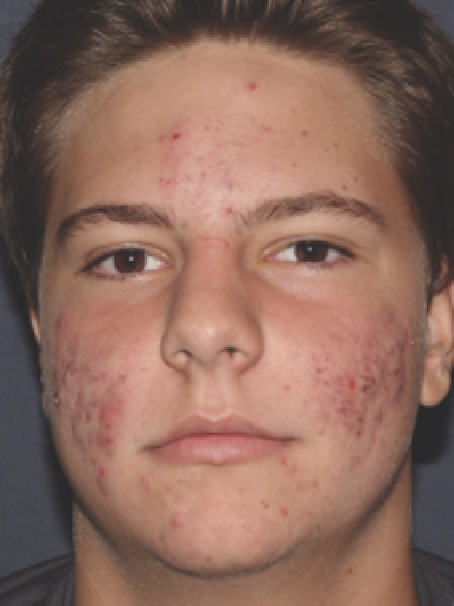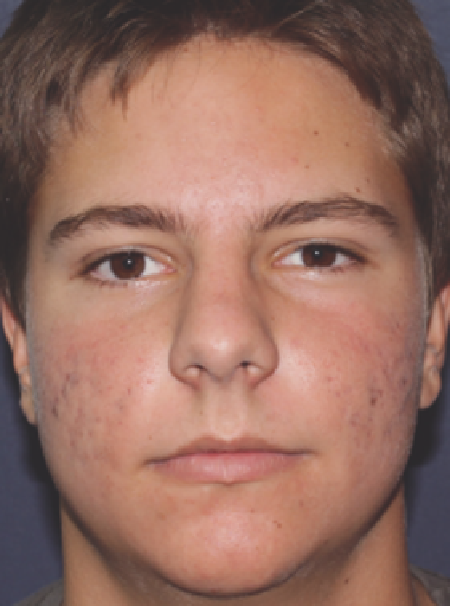Biomedical Engineering Reference
In-Depth Information
(120-180 minutes). We also use red LED (633 ± 5 nm) in addi-
tion to the blue light because sebaceous glands are deeply
located, approximately 0.5-1.0 mm from the cutaneous sur-
face (231). Therefore, PDL is used to target individual lesions
at subpurpuric settings, followed by blue and red light
irradiation.
Figure 10.19 illustrates a case of acne vulgaris after one ses-
sion of ALA-PDT.
Successful treatment of periungueal warts was reported by
Schroeter and colleagues with complete clearance in 90% of
warts after a mean of 4.5 treatments (235). Forty periungueal
and subungueal warts were pretreated with scalpel curettage
48 hours before the application of 20% ALA, with a mean
incubation time of 4.6 hours. Irradiation with light at
580-720 nm with 100 mW/cm
2
for 5-30 minutes was used in
the study. During the follow-up of 5.9 months, only two recur-
rences were observed.
PDT results for the treatment of genital warts in case series
and comparison trials reported clearance rates varying from
66% to 73% (236,237). A large study with 164 patients with
urethral condylomata reported 95% clearance rate after one to
four sessions with ALA-PDT (10% ALA, 3 hours incubation,
630 nm, 100 J/cm
2
, 100 mW/cm
2
) (238). High remission rates
were also reported by Chen and colleagues (239) in the treat-
ment of condylomatas of the urethra and external genitalia.
They compared ALA-PDT (20% ALA, 3 hours incubation,
633 nm, 100 J/cm
2
, 100 mW/cm
2
) with conventional carbon
dioxide (CO
2
) laser in 86 patients and found 100% clearance
after two PDT treatments and one CO
2
laser treatment, respec-
tively. Moreover, during follow-up of 12 weeks, they found a
recurrence rate of 6.3% and 19.1% for the ALA-PDT and CO
2
laser, respectively, which was signifi cantly different between
these two groups (
P
< 0.05). However, disappointing results of
PDT were seen in 175 patients with condylomata acuminate
treated with CO
2
laser vaporization plus adjuvant ALA-PDT
or adjuvant placebo-PDT (240). This prospective, randomized,
double-blind study compared 20% ALA or placebo ointment
applied to the lesion, 4-6 hours before CO
2
laser vaporization,
followed by red light (600-740 nm, 100 mW/cm
2
, 100 J/cm
2
).
Vulgar Warts and Genital Warts
Although many therapeutic modalities for viral warts exist,
sometimes the human papillomavirus causes highly refractory
skin disorders. Original guidelines reported clearance rates of
56-100% (232). Fabbrocini and colleagues conducted a con-
trolled study with 64 plantar warts treated with 20% ALA
under occlusion for 5 hours (400-700 nm, peaking at 630 nm,
50 J/cm
2
), while 57 lesions (controls) received only the vehicle
(233). Pretreatment with an ointment containing 10% urea
and 10% salicylic acid was applied for 7 days to remove the
superfi cial hyperkeratotic layer of the warts. All lesions were
treated once and repeated weekly if required for a maximum of
three sessions. After two months, the authors found 75% clear-
ance rate in the ALA-PDT group compared with 22% reduc-
tion in the untreated warts. A comparison study with ALA-PDT
using either PDL or LED versus PDL alone (ALA 3 hours, PDL
at 595 nm and 20 J/cm
2
, LED at 635 nm and 50 J/cm
2
) found
that a combination of PDT and PDL is the most effective, with
clearance rates of 100% (mean 1.96 treatments), 96% (mean
2.54 treatments), and 81% (mean 3.34 treatments), respec-
tively (234). It should be noted that the verruca was curetted
until visible bleeding occurred before ALA gel was applied.
(
A
)
(
B
)
Figure 10.19
Patient with acne vulgaris (
A
) at baseline and (
B
) 3 months after one session of aminolevulinic acid-photodynamic therapy showing signifi cant
improvement of infl ammatory papules and pustules.


















